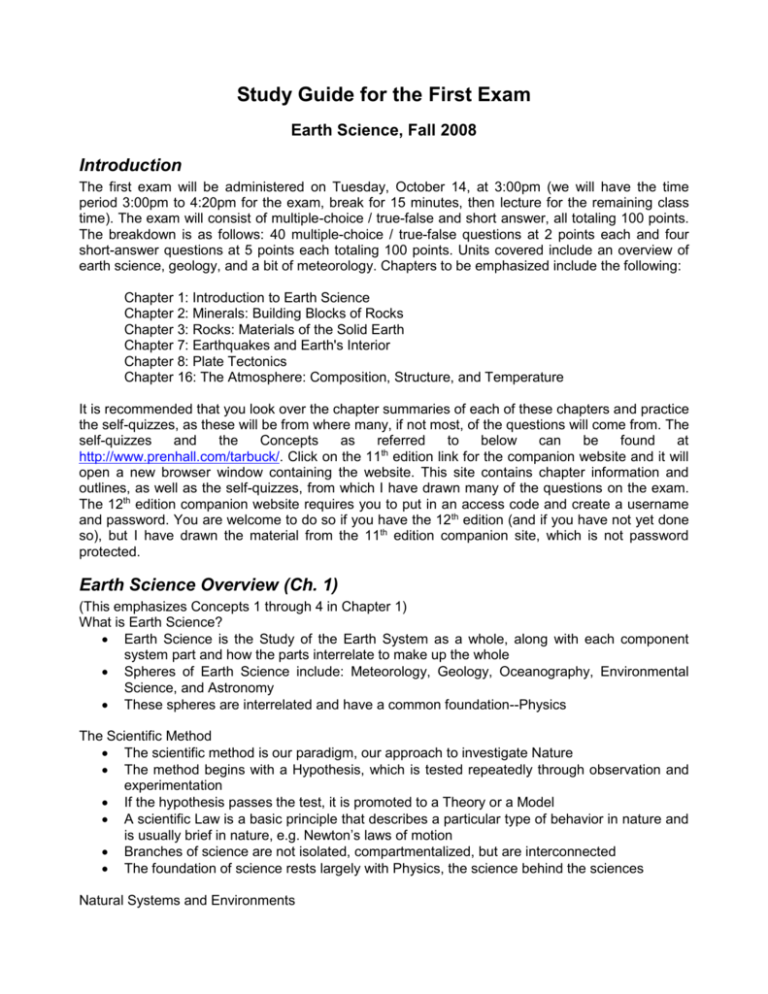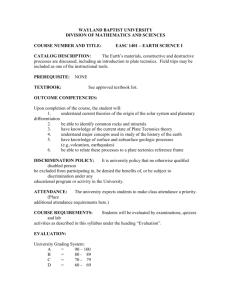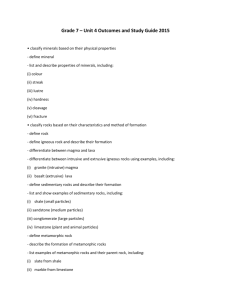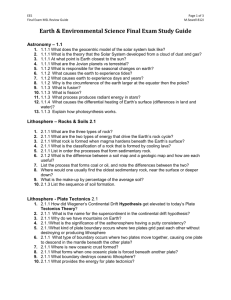What is Earth Science
advertisement

Study Guide for the First Exam Earth Science, Fall 2008 Introduction The first exam will be administered on Tuesday, October 14, at 3:00pm (we will have the time period 3:00pm to 4:20pm for the exam, break for 15 minutes, then lecture for the remaining class time). The exam will consist of multiple-choice / true-false and short answer, all totaling 100 points. The breakdown is as follows: 40 multiple-choice / true-false questions at 2 points each and four short-answer questions at 5 points each totaling 100 points. Units covered include an overview of earth science, geology, and a bit of meteorology. Chapters to be emphasized include the following: Chapter 1: Introduction to Earth Science Chapter 2: Minerals: Building Blocks of Rocks Chapter 3: Rocks: Materials of the Solid Earth Chapter 7: Earthquakes and Earth's Interior Chapter 8: Plate Tectonics Chapter 16: The Atmosphere: Composition, Structure, and Temperature It is recommended that you look over the chapter summaries of each of these chapters and practice the self-quizzes, as these will be from where many, if not most, of the questions will come from. The self-quizzes and the Concepts as referred to below can be found at http://www.prenhall.com/tarbuck/. Click on the 11th edition link for the companion website and it will open a new browser window containing the website. This site contains chapter information and outlines, as well as the self-quizzes, from which I have drawn many of the questions on the exam. The 12th edition companion website requires you to put in an access code and create a username and password. You are welcome to do so if you have the 12th edition (and if you have not yet done so), but I have drawn the material from the 11th edition companion site, which is not password protected. Earth Science Overview (Ch. 1) (This emphasizes Concepts 1 through 4 in Chapter 1) What is Earth Science? Earth Science is the Study of the Earth System as a whole, along with each component system part and how the parts interrelate to make up the whole Spheres of Earth Science include: Meteorology, Geology, Oceanography, Environmental Science, and Astronomy These spheres are interrelated and have a common foundation--Physics The Scientific Method The scientific method is our paradigm, our approach to investigate Nature The method begins with a Hypothesis, which is tested repeatedly through observation and experimentation If the hypothesis passes the test, it is promoted to a Theory or a Model A scientific Law is a basic principle that describes a particular type of behavior in nature and is usually brief in nature, e.g. Newton’s laws of motion Branches of science are not isolated, compartmentalized, but are interconnected The foundation of science rests largely with Physics, the science behind the sciences Natural Systems and Environments System = a group of interacting parts that forms a complex whole (can you think of some examples in the everyday realm?) Environment = everything that surrounds and influences an organism (what comes to mind when we mention “environment”?) Energy sources that power the Earth system include external (the Sun) and internal (heat from the interior of the Earth) The Physics that help us understand Earth Science: Gravity Our knowledge of gravity developed over the centuries through Newton and Kepler Gravity is the attractive force between two objects of mass, but is the weakest of the four known forces in Physics The strength of the force directly depends on the masses of the objects, and also falls as the square of the distance (that is double the distance, the force drops by a factor of four) Newton’s Laws of Motion form the basis of classical mechanics, and Newton’s Law of Universal Gravitation states that gravity is the same beyond the Earth and to the ends of the Universe By comparing the motion of the Moon to that of falling objects on Earth, Sir Isaac Newton concluded that gravitational forces were responsible for both. The Forces that Shape the Earth both inside and Out The primary driver of the external sculptors of Earth’s surface is the Sun, driving the Atmosphere and the Ocean resulting in the following mechanisms Weathering- the mechanical breakdown of rock by wind and water Mass Wasting-the transfer of weathered rock, soil, and sediment downslope under the influence of gravity Erosion-incorporation and transport of surface materials by wind, water, etc. Agents of external weathering, erosion, and mass wasting include the following (don’t worry about memorizing the various types of stream and river drainage patterns…) Streams and rivers, lakes and oceans, and groundwater; Glaciers and how these change the landscape; Rain, snow, hail, sleet, accumulation, melt The forces that shape the earth from inside have a common driver: the internal heat of our planet, which is vented through volcanoes and plate boundaries The process of Plate Tectonics plays a major role in the shaping of Earth’s surface over long time spans. Earth Materials: Rocks and Minerals (Ch. 2 & 3) (This emphasizes Concepts 1 and 2 of Chapter 2, and concept 3 of Chapter 3) Rocks versus Minerals A mineral is a naturally occurring inorganic solid possessing a definite chemical structure that gives it a unique set of physical properties. Most rocks are aggregates composed of two or more minerals. Atoms are the building blocks of materials An atom is the smallest particle of matter that still retains the characteristics of an element. Each atom has a nucleus containing protons and neutrons with electrons orbiting the nucleus. The number of protons in an atom's nucleus determines its atomic number and the name of the element. Atoms bond together to form a compound by either gaining, losing, or sharing electrons with another atom. Source of Radioactive Decay Isotopes are variants of the same element but with a different mass number (the total number of neutrons plus protons found in an atom's nucleus). Some isotopes are unstable and disintegrate naturally through a process called radioactive decay. Formation and cooling of rock Igneous rock forms from magma that cools and solidifies in a process called crystallization. Sedimentary rock forms from the lithification of sediment. Metamorphic rock forms from rock that has been subjected to great pressure and heat in a process called metamorphism. The rate of cooling of magma greatly influences the size of mineral crystals in igneous rock. The four basic igneous rock textures are (1) fine-grained, (2) coarse-grained, (3) porphyritic, and (4) glassy. Forces Within: Plate Tectonics, Earthquakes, Earth’s Interior (Ch. 7 & 8) (The following focuses on Concepts 1 and 5 of Chapter 7 and 1 to 4 of Chapter 8) Plate Tectonics and Geologic Dating Schemes • The theory of plate tectonics holds that Earth's rigid outer shell, called the lithosphere, consists of • • • • • • • • • • • seven large and numerous smaller segments called plates that are in motion relative to each other. • The plates consist of lithospheric crust afloat on a “sea” of asthenosphere and heating from below drives currents in the asthenosphere which in turn carries the plates along Most of Earth's seismic activity, volcanism, and mountain building occur along the dynamic margins of these plates. Evidence for Plate Tectonics include Shapes of the Continents Fossil Record and extant species distribution Mineral and Rock distribution Types of Plate Interactions: divergent plate boundaries, convergent boundaries, and transform boundaries (earthquakes) Two types of dates used by geologists to interpret the history of the earth include: • Relative dates—puts the events in their proper sequence of formation • Numerical dates—which pinpoint the time in years when an event took place Relative dates established by the law of superposition, principles of original horizontality, crosscutting relationships, inclusions, and non-conformities. Radioactivity is the spontaneous break-up (decay) of unstable atomic nuclei and come in three common types: • Emission of alpha particles (helium nuclei) from the nucleus • Emission of beta particles (electrons) from the nucleus) • Capture of electrons by the nucleus An unstable isotope or Parent will decay and form stable daughter products Half-life is the length of time for half of a given sample to decay to daughter products If the half-life of an isotope is known and the parent/daughter ratio can be measured, the age of a sample can be calculated Two types of dates used by geologists to interpret the history of the earth include: • Relative dates—puts the events in their proper sequence of formation • Numerical dates—which pinpoint the time in years when an event took place Relative dates established by the law of superposition, principles of original horizontality, crosscutting relationships, inclusions, and non-conformities. Earthquakes and the Earth’s Interior • Earthquakes • • are vibrations of Earth produced by the rapid release of energy from rocks that rupture because they have been subjected to stresses beyond their limit. This energy, which takes the form of waves, radiates in all directions from the earthquake's source, called the focus or epicenter. As indicated by the behavior of P and S waves as they travel through Earth (remember, at least basically, how this “picture” is “painted” of the interior of the Earth), the four major zones of Earth's interior are the (1) crust (the very thin outer layer), (2) mantle (a rocky layer located below the crust with a thickness of 2885 kilometers), (3) outer core (a layer about 2270 kilometers thick, which exhibits the characteristics of a mobile liquid), and (4) inner core (a solid metallic sphere with a radius of about 1216 kilometers). The crust and uppermost mantle form Earth's cool rigid outer shell called the lithosphere. Beneath the lithosphere lies a soft, relatively weak layer of the mantle known as the asthenosphere. Weather and Climate The Composition and Structure of the Atmosphere (Ch. 16) (This emphasizes all five Key Concepts as given on the text’s website) • Weather is the state of the atmosphere at a particular place and time. Climate is a generalization of the weather conditions of a place over a long period of time and includes both averages and extremes. • In summary, there are at least 5 ingredients that result in weather, as we know it: o Sun / Solar Radiation o Atmospheric Circulation o Water Vapor o Rotation of the Earth o Land forms and Oceans • The most important elements, those quantities or properties that are measured regularly, of weather and climate are (1) air temperature, (2) humidity, (3) type and amount of cloudiness, (4) type and amount of precipitation, (5) air pressure, and (6) the speed and direction of the wind. • The atmosphere is made up of nitrogen (N), about 78% of the atmosphere by volume, and oxygen (O2) about 21%. •Carbon dioxide (CO2), although present only in minute amounts (0.036%), is an important greenhouse gas, and so with water vapor (H2O), a variable component of the atmosphere. •Ozone (O3), is concentrated in the 10- to 50-kilometer altitude range of the atmosphere, and is important to life because of its ability to absorb potentially harmful ultraviolet radiation from the Sun. • Because the atmosphere gradually thins with increasing altitude, it has no sharp upper boundary but simply blends into outer space. o Based on temperature, the atmosphere is divided vertically into four layers. o The troposphere is the lowermost layer, where weather occurs. In the troposphere, temperature usually decreases with increasing altitude. This environmental lapse rate is variable, but averages about 6.5°C per kilometer (3.5°F per 1000 feet). o Above the troposphere is the stratosphere, which exhibits warming because of absorption of ultraviolet radiation by ozone. o In the mesosphere, temperatures again decrease. o Upward from the mesosphere is the thermosphere, a layer with only a tiny fraction of the atmosphere's mass and no well-defined upper limit. The Reasons for the Seasons and Electromagnetic Radiation • The • two principal motions of Earth are (1) rotation, the spinning of Earth about its axis, which produces the daily cycle of daylight and darkness; and (2) revolution, the movement of Earth in its orbit around the Sun. Several factors act together to cause the seasons. Earth’s axis is inclined 23.5° from the perpendicular to the plane of its orbit around the Sun and remains pointed in the same direction (toward the North Star) as Earth's journeys around the Sun. As a consequence, Earth's orientation to the Sun continually changes. The yearly fluctuations in the angle of the Sun and length of daylight brought about by Earth’s changing orientation to the Sun cause the seasons. • The three mechanisms of heat transfer are (1) conduction, the transfer of heat through matter by molecular activity; (2) convection, the transfer of heat by the movement of a mass or substance from one place to another; and (3) radiation, the transfer of heat by electromagnetic waves. • Electromagnetic radiation is energy emitted in the form of rays, called electromagnetic waves, whose wavelengths range from very long radio waves to very short gamma rays. Visible light is the only portion of the electromagnetic spectrum we can see. Some of the basic laws that govern radiation as it heats the atmosphere are (1) all objects emit radiant energy; (2) hotter objects radiate more total energy than do colder objects; (3) the hotter the radiating body, the shorter the wavelengths of maximum radiation; and (4) objects that are good absorbers of radiation are good emitters as well. Possible Questions to be used as Short Answer The Short Answer portion of the exam will consist of four questions, selected from the list below, which require a response consisting of a phrase to a few sentences in length. Each short answer will be worth 5 points. 1. What is Earth Science? 2. What is Science in general? 3. How does the Scientific Method work? 4. What is the difference between a rock and a mineral? 5. How does plate tectonics work? 6. After traveling through space, sunlight reaches the top of the atmosphere on the day side of the Earth. List and briefly describe 3 to 4 things that happen to sunlight after it reaches the Earth’s atmosphere 7. What is the Greenhouse effect? (FYI: the BBC website has an excellent animation that shows how it works; to access the animation, go to http://news.bbc.co.uk/2/shared/spl/hi/sci_nat/04/climate_change/html/greenhouse.stm which includes excellent tutorials and animations on several aspects of climate change) 8. What is electromagnetic radiation?







